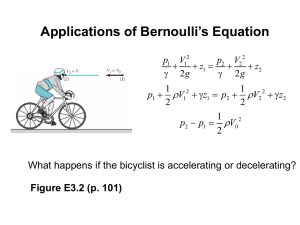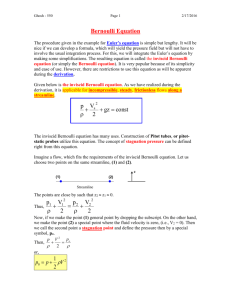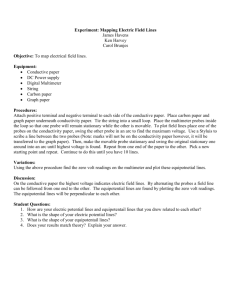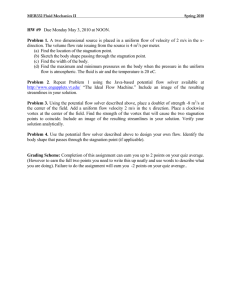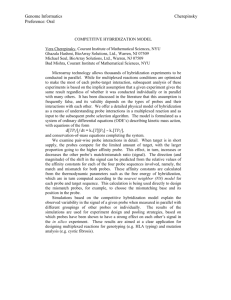ME 322: Instrumentation Lecture 6
advertisement
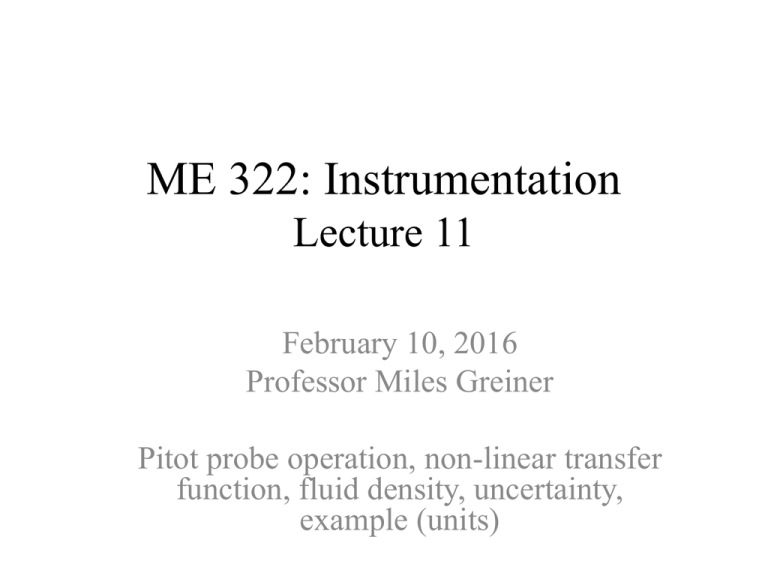
ME 322: Instrumentation Lecture 11 February 10, 2016 Professor Miles Greiner Pitot probe operation, non-linear transfer function, fluid density, uncertainty, example (units) Announcement/Reminders • HW 4 due now (will accept Friday with no penalty) – Monday: President’s Day Holiday – Wednesday: HW 5 due, Midterm Review – Next Friday: Midterm I • Evening with Industry (UNR Society of Women Engineers) – – – – – Tuesday, February 16, 2015 (Tuesday) Networking 5:30pm-6:30pm (business attire) Dinner and Keynote Speaker 6:30-8pm $25 (or free tickets from ME Office, first come first served) If you pickup a free ticket, please show-up • How is Lab 4 going? – Sorry about the old sticky glue… – We ordered more but they didn’t ship until last Friday Service-Learning Extra Credit Opportunity • The Regional Science Olympiad is a competition which tests middle and high school teams on various science topics and engineering abilities • It will be held 8 am to 4 pm Saturday, March 5th 2016 – Where? • ME 322 students who participate in observing and judging the events for at least two hours (as reported by Rebecca Fisher) will earn 1% extra credit. • To sign up, contact Ms. Fisher, rnfisher@unr.edu, (775) 682-7741 by Wednesday, February 24 to sign up. – If you sign-up but don’t show-up you will loose 1%! • Details – You cannot get extra-credit in two courses for the same work. Lab 5 Sample Report • Calculate 𝐸 in GPa – Then calculate 𝑤𝐸 /𝐸 and 𝑤𝐸 – Reference citation • Books: Author, Title, publisher, pages, copyright date • Make table fonts large enough to see – Include Units – Answer questions based on data • Write abstract last – Objective, Methods, Findings, (suggestions) – http://wolfweb.unr.edu/homepage/greiner/teaching/MECH322Instrumentation/L abs/Lab%2005%20Elastic%20Modulus/Lab%20Index.htm Fluid Speed • Fluid velocity is a vector 𝑉 𝑥, 𝑦, 𝑧 field – At each location has a magnitude and direction – 𝑉 = (𝑢, 𝑣, 𝑤) = (𝑣𝑥 , 𝑣𝑦 , 𝑣𝑧 ) 𝑉 • Speed is a scalar – Local velocity Magnitude –𝑉= 𝑣𝑥2 + 𝑣𝑦2 + 𝑣𝑧2 – Units: 𝑚 𝑓𝑡 𝑚𝑖𝑙𝑒𝑠 , , 𝑠 𝑚𝑖𝑛 ℎ𝑟 • Why measure it? 𝑣𝑥 𝑣𝑧 𝑣𝑦 – Weather (wind speed), Aircraft air speed, river flow rates, fan performance, HVAC, confirm CFD simulations Pressure Measurement Method PS PT > PS PT > PS PS V • When an obstruction is placed in a flow it causes the fluid to decelerate and stop, and increases the pressure – PS = Static Pressure • Measured by an observer traveling with the fluid, or on a flat surface parallel to the flow – PT = Total (or Stagnation) Pressure • Measured at stagnation point, where V = 0 • Pitot probes are designed to transmit PT (Affects flow!) • Pitot-Static probes transmit both PT (inner tube) and PS (outer tube) Stagnation Point V Speed PS Static Pressure r density V = 0, P = PT • Along the blue line, the fluid decelerates and stops (at the Stagnation Point) • Viscosity does not play an important role in this process • Problem: If the flow changes so the stagnation point is not at the opening, then the probe will not transmit PT. Related Devices • • • • Boundary Layer probes transmit PT near walls Keil probes transmit PT even when flow direction changes Aircraft probes measure air speed Pitot-Static probes are used in Wind Tunnel Labs (6 and 11) Bernoulli Equation V, PS, r V = 0, PT • Assumptions – Steady, inviscid (no viscosity, m = 0), incompressible (r = constant), subsonic (V << sound speed) • 2 2 𝑉 𝑉𝑆 2 + 𝑃𝑆 𝜌 𝑉𝑇2 2 + 𝑧𝑆 𝑔 = + 𝑃𝑇 𝜌 + 𝑧𝑇 𝑔 – 𝑉𝑠 = 𝑉, 𝑉𝑇 = 0, assume 𝑧𝑆 = 𝑧𝑇 , multiply by r • 𝑃𝑇 − 𝑃𝑆 = ∆𝑃 = 1 𝜌𝑉 2 2 Reading Measurand • Transfer Function – Output Reading ∆𝑃 as a function of Measurand 𝑉 – Measure ∆𝑃 using a pressure transmitter, manometer, … Ideal (inviscid) Transfer Function ∆𝑃 [𝑃𝑎] 𝜕∆𝑃 𝜕𝑉 𝑤∆𝑃 ∆𝑃 𝑤𝑉 • ∆𝑃 = 1 𝜌𝑉 2 2 – Sensitivity 𝑉 m s V[ ] : Non-linear 𝜕∆𝑃 𝜕𝑉 = 𝜌𝑉 increases with 𝑉 – Input resolution 𝑤𝑉 = 𝑤∆𝑃 / than at small values 𝜕∆𝑃 𝜕𝑉 is smaller (better) at large 𝑉 • Better for measuring large 𝑉 than for small ones To use Pitot Probe • Invert transfer function: ∆𝑃 = • 𝑉=𝐶 1 𝜌𝑉 2 2 2∆𝑃 𝜌 – The Constant C accounts for viscous effects, which are small • Assume C = 1 unless told otherwise – Pitot probes generally do not need to be calibrated • Calibration does not change with time (if clean) – Can be used to calibrate other speed measuring devices • Such as “hot-film” probes (Lab 11) Uncertainty in V • 𝑉=𝐶 2∆𝑃 𝜌 (Is This a Power Product?) • Best Estimate –𝑉=𝐶 • 𝑤𝑉 2 = 𝑉 2∆𝑃 𝜌 Fill in Blank How to Find Density • Ideal Gases –𝜌= 𝑃 𝑅𝑇 = 𝑃 𝑀𝑀 𝑅𝑈 𝑇 (Power Product?) • P = PS = Static Pressure • R = Gas Constant = RU/MM – Ru = Universal Gas Constant = 8.314 kJ/kmol K – MM = Molar Mass of the flowing Gas – For air: R = 0.2870 kP*m3/kg*K • T [K] = Absolute Temperature = T[°C] + 273.15 • 𝑤𝜌 2 𝜌 = FIB • Liquids – 𝜌 = 𝑓𝑛 𝑇 ≠ 𝑓𝑛(𝑃) – Tables Water Properties (Appendix B of Text) “British” Units Air (at 1 ATM, not other pressures) Example • A Pitot-static probe is used to measure air speed in a wind tunnel. If the air temperature and (static) pressure are T = 27±1°C (95%) and P = 86±2 kPa (95%), and the difference between the total and static pressures is DP = 55±3 Pa (95%), what is the confidence interval for the speed? – Solution (first identify, then do) • ID: – – – – What is the fluid? Do all uncertainties have the same certainty-level? Asked for Likely or Maximum Uncertainty? Units • Do: on white board Fluid Flow Rates A dA V, r 𝑚= 𝑑𝑚 = 𝐴 𝜌𝑉𝑑𝐴 𝐴 • Within a conduit cross section or “area region” – Pipe, open channel, river, blood vessel (not always steady) – V and r can vary over cross section • Mass Flow Rate, 𝑚 [kg/s, lbm/min, mass/time] – 𝑚 = rAQ (How to measure this for steady liquid flow?) • Average Density: rA [kg/m3] • Volume Flow Rate, Q [m3/s, gal/min, cc/hour, Vol/time] –Q= 𝐴 • Averages 𝑉𝑑𝐴 = VAA (How to measure this for steady liquid?) – Density: rA = 𝑚/𝑄 – Speed: VA [m/s] = 𝑄/𝐴 = 𝑚/ArA Many Flow Rate Measurement Devices Turbine Rotameters (variable area) Laminar Flow Vortex (Lab 11) Coriolis • Each relies on different phenomena • When choosing, consider Variable Area – cost, stability of calibration, imprecision, dynamic response, flow resistance Pitot-Static Probe V, Speed PS, Static Pressure r, density P = PS V=0 P = PTotal = PT P = PS P = PT • Concentric tubes – Port for inner tube at stagnation point, measures total (or stagnation) pressure, PT (pressure observed after the flow is stopped) – Port for outer tube at side, measures static pressure, PS (observed when moving with the flow) • Use a pressure transmitter to read – DP = P T – P S • Measurand: U

